How Ovechkin's oldest trick remains so hard to defend
If you ask a hockey fan to close their eyes and imagine an Alex Ovechkin goal, almost every one of them will picture the same thing.
Left faceoff circle. Power play. One timer. The puck travels so fast it’s barely visible. The goalie looks so lost he doesn’t know what continent he’s on.

You don’t have to watch Washington Capitals hockey regularly to have seen it again and again. It’s the most iconic shot in the NHL. Ovechkin has been doing it for 14 years at the highest level with no sign of slowing up.
Two weeks ago, against the New York Rangers, the seven-time Rocket Richard Trophy winner, scored a pair exactly that way. One was more of a knuckle puck than the other, but otherwise they were more or less identical:


Ovechkin camps out near the back edge of the faceoff circle, waits for a feed from John Carlson, and blasts the puck through the opposing goaltender. Classic.
The 33-year-old has scored 233 power-play goals to date, most of them looking more or less like that. That isn’t just the most anyone else has managed since 2005-06, it’s 98 more than second-best (a spot on the leaderboard somehow occupied by Thomas Vanek). He’s led the league in power-play tallies six times, including every season in a five-year run from 2012-13 to 2016-17. Since he came into the league, the Capitals have an NHL-best 20.6 success rate with the man advantage. This year, their 37.2 percent is tops by 4.8 percent.
The whole run is based on something that would seem so predictable that there should be a way to slow it down, if not scheme it out of existence. Everyone knows what the Capitals power play is trying to do, so why can’t they put a stop to it?
In order to answer that question I watched every minute of every Capitals power play this season to see how a man as dangerous as Ovechkin manages to get so open, so often. Here are a few of the takeaways:
Ovechkin is deadly from farther out than almost anyone
Against a power play that is executing, it’s almost impossible to prevent shots from being taken. Instead, the goal of a good penalty kill is to cut down high-danger shots. That usually means closing down the slot and trying to force opponents to let it rip from far enough away that they’re unlikely to score.
The problem with Ovechkin is that his shot is so powerful that the “high-danger” area extends a lot further from the net than it does for most players. That leaves defenders with a choice of breaking their formation and following him out to his spot — leaving a passing lane to slot man T.J. Oshie open — or staying close to the net, keeping their box tight, and letting Ovechkin post up essentially by himself.
A dilemma like that can be tricky as Deryk Engelland shows on this chance where he gets caught between staying in his position down low and really challenging Ovechkin’s shot out beyond the circle.
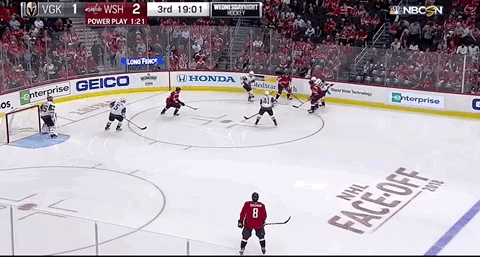
More often that not, opposing teams opt to keep their defenders as close to the net as possible, making it impossible for them to get close enough to Ovechkin to alter his shot before it’s already off.
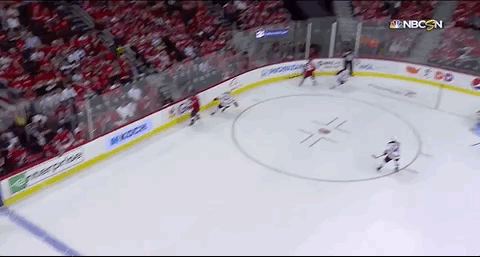
There’s no right answer here for clubs going up against Ovechkin. Playing their forward where he likes to hang out would distort the shape of their penalty kill and open up more possibilities around the crease. It certainly doesn’t feel great to let him fire rockets with impunity, though.
The best you can do is probably have a player who’s maintaining the geometry of the kill, but checking up on Ovechkin as much as possible. John Tavares provided a good example how that might work when the Capitals played the Toronto Maple Leafs.

In this sequence, Tavares keeps an eye on the puck and stays in a more or less traditional position, but he continually looks over his shoulder to see where Ovechkin is. Because of his awareness on the play, he’s able to block a potentially-dangerous one timer with his stick.
Marking him is easier said than done though because…..
Ovechkin plays almost exclusively off the puck
The Capitals have been on the power play for 50:48 this season, but the puck has been on Ovechkin’s stick for a minuscule percentage of that time.
Whether it’s off the rush or during a period of sustained possession, Washington makes a concerted effort to keep the puck away from Ovechkin’s lumber until that rubber is ready to leave it at a blistering pace.
Virtually every time the Capitals make a zone entry, they do so in force on the right side of the ice, which gives Ovechkin room to creep in on the left without a soul around him — a situation that often results in him getting his shot off, if the Capitals can maintain possession of the puck.
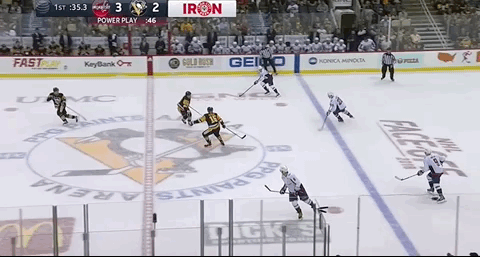
Even if it takes a little while to get control of the puck, it can still usually get to Ovi before a defender does. In this case against the Pittsburgh Penguins, a rather messy entry still results in the kind of one timer Ovechkin has buried countless times.
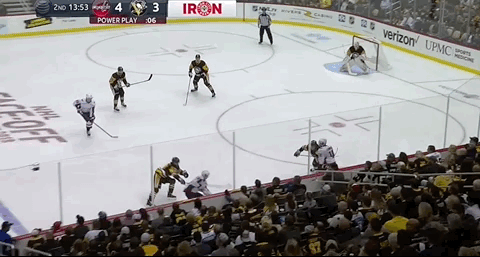
When you watch the Capitals power play, you’ll often see a full rush break out on the right side of the ice and Ovechkin standing utterly motionless on the blue line on the left. It’s an odd sight, but it puts him in a position where no one will pay him much attention, allowing him the ability to drift into a scoring position quickly. Here’s what it looks like on a play where the Capitals don’t manage to gain the zone:
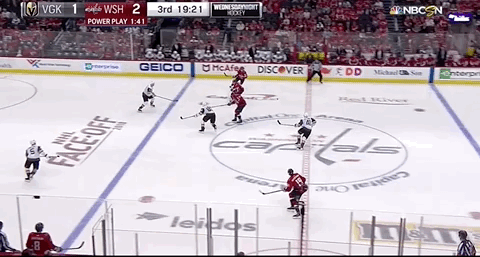
When the Capitals make it into the zone and start their cycle, they keep the action on the right, leaving their top goal scorer to roam the empty spaces on the other side of the ice. Because the penalty killers are forced to react to the puck, Ovechkin is often so open that he’s calling for the puck to go to Carlsson — not himself — because he knows that even if it takes two passes it’ll find him before the defence can reach his shooting lane.
Again, it’s a bit strange to see a hockey player standing alone on the ice pointing to a teammate, but it’s not uncommon for Ovechkin.
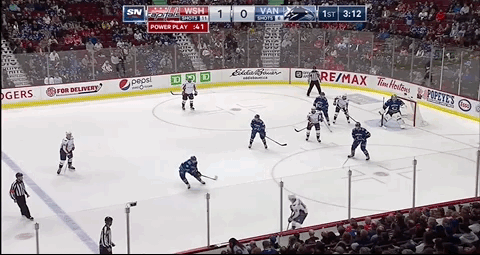

Ovechkin’s open spaces aren’t all the result of his puck avoidance, he also gets some help from his teammates, with one in particular standing out…
T.J. Oshie is an expert obstructionist
Of the five players on Washington’s top power play unit, Oshie is probably the most unheralded. Since the beginning of the 2017-18 season his 20 power-play points is tied for 86th in the NHL with names ranging from Erik Haula to Wayne Simmonds. That’s not a bad number by any means, but not a “straw that stirs the drink” number.
However, Oshie does play a stealthy role in Ovechkin’s success. Beyond drawing the attention of defenders to the front of the net and giving him space, he also does an excellent job obstructing penalty killers who might cover the Russian goal scorer.
Because Ovechkin is always deployed on the left side, Oshie knows the forward at the top-right corner of the box will be responsible for his captain. That means if he ties up that player, Ovi’s shot will be unimpeded.
Here are two examples of Oshie doing just that, even though it significantly reduces his odds of getting a scoring chance of his own. None of them result in goals, but every time Ovechkin is able to fire off a dangerous shot with plenty of time and space:

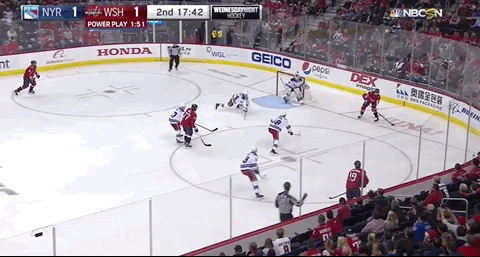
Oshie’s plays have a bit of a “pick” feel to them. He’s initiating contact in order to spring his teammate. Normally you think of a slot player as being ready for a pass at all times, but he forgoes that because getting the puck was never part of the plan.
The veteran winger is a subtle help to Ovechkin, but his more obvious helper is the man he lines up next to on the point.
John Carlson is also a looming threat
Although it’s often been hypothesized that Carlson’s numbers are inflated due to the players that surround him, when it comes to teeing up Ovechkin the role he plays is crucial.
Ovechkin has scored 21 power-play goals since the beginning of last season. The defenceman has the primary assist on 14 of them. He certainly benefits from Ovi’s finishing ability, but part of the reason he’s so effective setting him up is because he’s a threat in his own right. His five power-play goals since the beginning of 2017-18 don’t sound like much, but only eight defenceman have more and only seven have more shots on goal.
He’s not peak Shea Weber, but he’s enough to keep penalty killers honest. When he gets a chance he can certainly bury the puck.

Much like Oshie, Carlson is able to affect the top-right penalty killer. Instead of tying him up, he keeps the forward away from Ovechkin by making him honour the point shot. Penalty killers are taught to get in front of potential shots, and when they react to his, that can leave Ovechkin wide open.
For example, this goal comes to pass by a combination of a fortuitous broken stick and Carlson sucking penalty killers down the middle of the ice to take his shot away. By the time the Canucks start to drift towards Ovechkin, it’s far too late.

Even though everyone on the ice knows Ovechkin is the top threat, they don’t want to be caught leaving the middle of the ice wide open for Carlson to bang one right into the twine — especially if it was possible to get in his way.
Fourteen years into the Alex Ovechkin experience, his signature play isn’t going anywhere. Since he came into the league he’s taken 1,413 power-play shots — 463 more than second-place Evgeni Malkin, and more than double the total of all but four other players. He’s missed 709 shots — 290 more than the notoriously accuracy-challenged Dion Phaneuf. He’s played 850:42 more minutes with the man advantage than anyone else. Ovi launching power-play one timers is an NHL institution like few others.
The reason it continues to be to this day is because it’s still immensely effective. Ovechkin is complemented extraordinarily well by his teammates, whether it’s Carlson and Oshie or Evgeny Kuznetsov and Nicklas Backstrom, who are dangerous off the rush, do an excellent job with zone entries and make crisp passes down low.
He’s also got a special combination of brains and brawn that grants him the awareness to glide into the right spot at the right time and the power to make good on enough of his opportunities to justify the whole apparatus working to get him the puck.
One day, Ovechkin won’t be able to do this anymore. Maybe he’ll lose a fraction of a second of reaction time and stop hitting the one timer as cleanly. Perhaps his supporting cast will falter. Maybe his endurance will slip to the point he simply can’t play obscenely long power-play shifts anymore.
Whatever the case may be, there may come a day where the Ovechkin laser is no longer the deadliest play in hockey. It’ll be a sad day for the Capitals, but from the looks of things that day’s not coming any time soon.
More NHL coverage from Yahoo Sports


